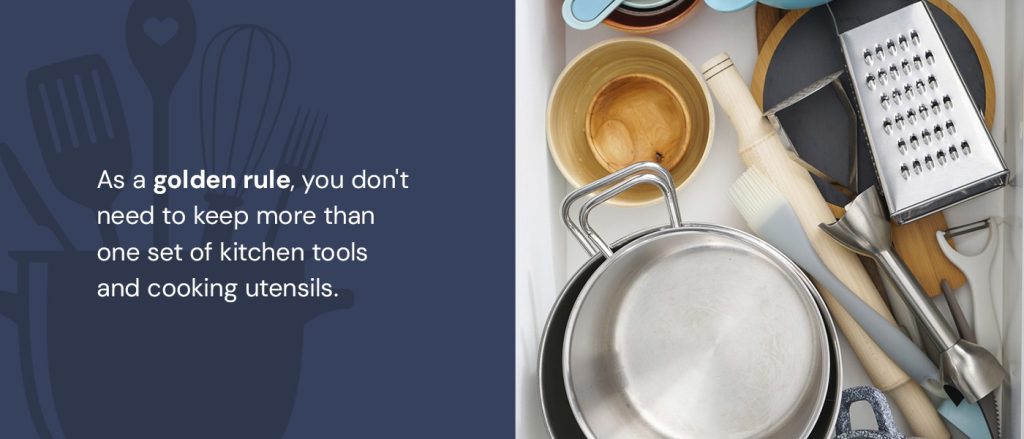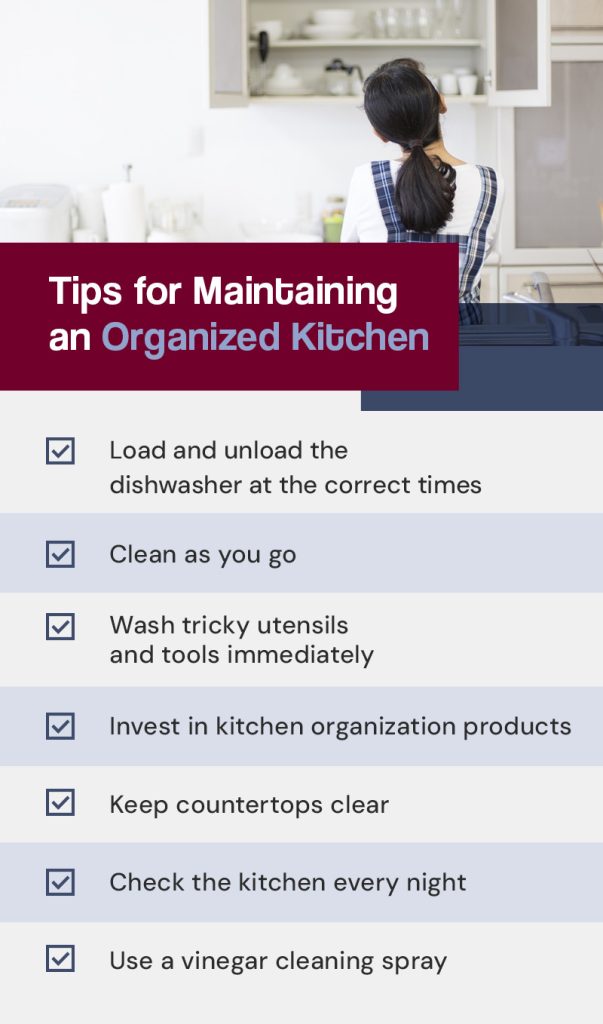

Are you moving into a new apartment and looking for tips to keep it clean? Is your current kitchen starting to get messy? You might benefit from some kitchen storage ideas to help you organize it and make it more efficient.
Whether making breakfast and coffee in the morning or dinner in the evening, your kitchen setup affects how your day starts and ends. So, instead of working around your kitchen, make it work for you by organizing it effectively!
Organizing and deep cleaning your space gives you a clean slate and brings a calmer feel to the area. It can also create a more functional space, allowing you to make better use of your kitchen.
However, while kitchen storage and organization help you make the most of your home, you need to give it some thought before you start. What do you use the kitchen for the most? For example, if you make cups of tea or coffee several times a day, then you might want to make space to leave your kettle or coffee pot on the counter instead of in your overhead cupboards.
Also, consider if any areas cause traffic jams or frustrations in the kitchen. For example, if the pots are too far away from the stove or the cooking spoons are mixed in with eating utensils, it could cause significant inconveniences when preparing meals.
Organizing to optimize kitchen space is important when entertaining guests or trying to maximize comfort. A clean kitchen makes cooking less stressful and helps you get more creative with your culinary inventions. Getting things in order is easy if you follow these steps for kitchen organization and storage.
To organize the space correctly, you have to understand what you’re working with. However, before you start emptying all the cupboards, make sure you have enough time to dedicate to cleaning your kitchen. Ideally, you don’t want dishes scattered about for more than a day.
When cleaning day arrives, go cabinet by cabinet and remove everything. You can temporarily place items on the counter, floor or in boxes. Line the area with newspapers or bubble wrap to prevent breaking and clanking. Emptying everything helps you to approach your kitchen as a blank slate and makes the next steps a lot easier.
Before you start brainstorming kitchen storage and organization ideas, you want to work in a clean space. Deep cleaning keeps the area cleaner for longer and makes it easier to maintain. It also ensures that your dishes and cutlery are kept in a hygienic place. Here’s how to clean different areas of your kitchen:
When performing a deep clean, aim to choose products without volatile organic compounds (VOCs). VOCs can contribute to headaches, allergic reactions and chronic respiratory issues. You can make a homemade kitchen cleaner by combining vinegar and water, and baking soda works well for scrubbing. For a nicer smell, you can add essential oils like tea tree and grapefruit to your vinegar solution. Alternatively, invest in a VOC-free cleaner to get the place sparkling while keeping the air free of harmful fumes.
Now, let’s get back to all the stuff you emptied of the cupboards and took off the shelf. To start implementing kitchen organization and storage solutions, say goodbye to some of the things you don’t need — nobody needs five sets of measuring cups!

As a golden rule, you don’t need to keep more than one set of kitchen tools and cooking utensils. Keep any duplicates in a separate box for backups, donating or a garage sale. Here are some of the essential kitchen tools that you should keep in sets for convenient cooking:
Don’t hold on to items that you haven’t used in years. If you have sentimental kitchen pieces that you don’t use but are still important to you, move them to other areas of your home where they may serve you better.
You should also let go of any broken utensils. It’s much easier to replace them, and buying new ones could save you time.
If you’ve got all your kitchen items lying in front of you and are having trouble deciding what to keep, creating organization piles is one of the best kitchen organization ideas. All you have to do is get three large boxes and label them:
Now that you’ve decided what you’ll keep, the next step is to find the most convenient place to put these items. Separating tools according to how you use them makes preparing and enjoying meals easier. Look at each space in your kitchen and organize items based on where you use them most frequently.
Let’s start with the day-to-day items you want to keep on your countertops. These should include things you use regularly and enjoy convenient access to. Creating zones in your kitchen based on what you use each area for helps simplify the process. For example:

Once you have an idea of what you want out in the open, you can decide what to put in your cabinets. Consider your kitchen zones and which items you want close by. Here are a few ideas:
Your pantry is where you’ll store all your nonperishable foods and ingredients, from oil and flour to noodles and cereals. Let’s start with the floor. Keep in mind that if you have pets, you may want to avoid storing food on the floor level, especially if you’re prone to leaving the pantry door open. Instead, start by placing heavier, bulk items like bottled water and cans of soda on the floor. You can also use the floor space to store large appliances you don’t use often or don’t fit in drawers or cabinets. Paper towel rolls also fit nicely down there.
Your pantry’s lower shelves are ideal for ingredients like flour, rice and sugar. Your lightest food items, like spices, condiments, snacks, tinned foods and cereals, can fill out its upper levels.
Your drawers are usually the most straightforward section of your kitchen to organize. The number of drawers you have to work with affects how you use them.
Typically, you place your cutlery, such as knives, forks and spoons, in a top drawer that’s close to your plates cabinet. In another drawer, you can place cooking or baking utensils like whisks, spatulas and measuring cups. A third drawer can hold dry towels, placemats, dishcloths and napkins. If you have other odds and ends that need a home, an extra drawer could be the perfect spot.
Now that your kitchen is fresh and clean, how do you keep it that way? It’s all about applying some basic principles to maintain cleanliness and a state of order. Here are some steps to keep your kitchen sparkling:

If you’re a culinary enthusiast, you may have more kitchen storage needs. While there are many ways to optimize your space with additions like floating shelves, racks and stands, you could also consider certain features when looking for a new apartment. For example, an island counter with more kitchen storage cabinets can make preparation and dining more convenient and efficient.
Here are some other helpful organizational kitchen features to look for when apartment hunting:
Are you looking for a townhome or apartment where you can express your inner foodie? Triple Crown Corporation offers a wide range of apartments in residential communities across Pennsylvania and Maryland with incredible features like kitchens that provide ample space.
If you’re ready to take advantage of more than 40 years of experience, contact our friendly team today and let us help you find your perfect home.